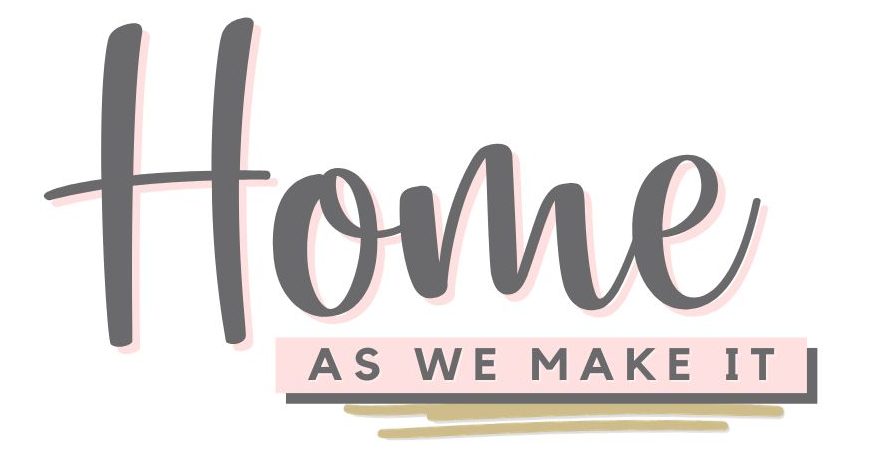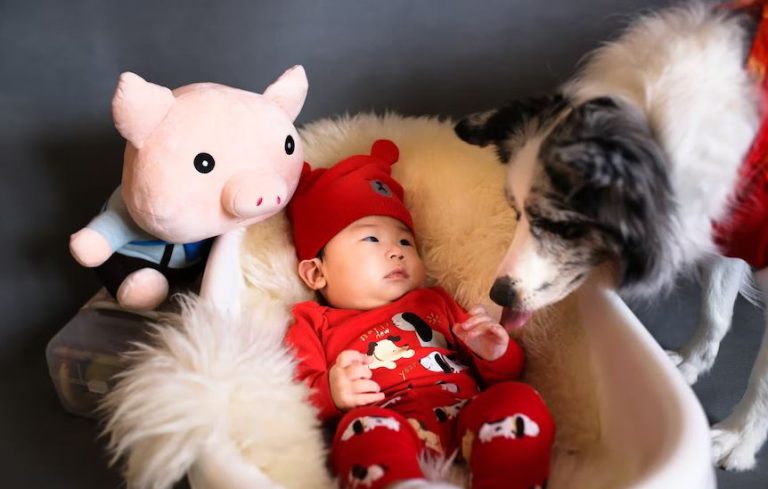Bathing Your Newborn: A Step-By-Step Guide To Safe And Effective Bathing
One of the essential tasks you will need to learn is how to bathe your baby safely and effectively.
Bath time not only helps keep your baby clean but also provides an opportunity for bonding and relaxation. In this step-by-step guide, we will walk you through everything you need to know about bathing your newborn.
Note: This post may contain affiliate links, which means if you buy from my link I might make a small commission. This does not affect the price you pay. See the full affiliate disclosure here.
From preparing the bath area to tips and tricks for making bath time fun and safe, we have got you covered. So take a deep breath, relax, and let’s get started on this journey of keeping your baby healthy and happy!
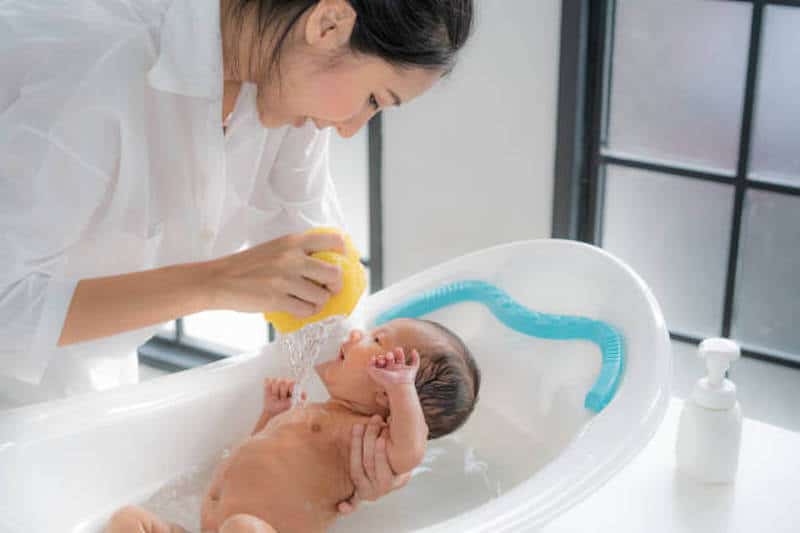
Prepare the Bath Area
Now it’s time to get everything ready for the perfect bath experience for your little one. To set up, make sure you have all the necessary supplies within arm’s reach before beginning.
This includes a clean towel, washcloth, gentle baby soap, and a basin or tub filled with warm water. You can also add toys or bubbles to make bath time more enjoyable for your baby.
Before placing your newborn in the water, it’s important to take safety precautions. Always test the temperature of the water with your elbow or wrist to ensure it’s not too hot or cold.
Never leave your baby unattended in the water and always keep a firm grip on them while they are bathing. These simple steps will help create a safe and enjoyable environment for both you and your little one during bath time!
Undress and Clean Your Baby
Undressing and cleaning your little one is a crucial part of the bathing process. It’s important to handle your newborn with care while undressing them, as they can be squirmy during bath time. Make sure to support their head and neck at all times while gently removing their clothes.
Once your baby is undressed, it’s time to clean their delicate skin. Start by using a soft washcloth or sponge dipped in warm water to wipe down your baby’s face, neck, arms, legs, and bottom. Be extra gentle around the eyes, nose, and mouth areas.
If your baby still has an umbilical cord stump present, avoid submerging it in water and instead use a cotton swab dipped in rubbing alcohol to gently clean around it. Remember to always keep one hand on your baby for support during this process!
Rinse and Dry Your Baby
Now that your little one is all clean, it’s time to rinse and dry them off. Make sure you use clean water to gently rinse away any soap residue.
Then, pat them dry with a soft towel, taking care not to rub their delicate skin too hard. Finally, apply some lotion or diaper cream as needed to keep their skin moisturized and protected.
Remember, these simple steps can go a long way in keeping your baby healthy and happy!
Use Clean Water to Rinse
Make sure to only use clean water when rinsing your little one during bath time to avoid any potential irritations or infections. Your baby’s skin is delicate and sensitive, so using contaminated water can cause harm.
Here are some tips to ensure you’re using clean water for your baby’s bath:
- Test the temperature of the water before using it on your baby. Make sure it’s lukewarm, around 37°C (98°F), by dipping your elbow or wrist into the water.
- Use fresh tap water that’s been running for a few minutes before filling up the tub or sink.
- Avoid adding bubble bath or other products that can irritate your baby’s skin.
- If you’re using a bucket or basin, make sure to change the water after each rinse.
By following these guidelines, you’ll help protect your little one from any unnecessary discomfort or health issues caused by contaminated water during their bath time routine. Remember that keeping things clean and simple is often best when it comes to taking care of newborns!
Pat Dry with a Soft Towel
Let’s keep your baby cozy and comfortable by patting them dry with a soft towel after their bath. Remember that babies have delicate skin, so using a rough towel can cause irritation or even injury. Invest in a few soft, absorbent towels that you use exclusively for your baby’s baths.
When drying your little one, start by gently patting them down, paying extra attention to the folds of their skin where moisture can get trapped. Avoid rubbing or scrubbing too hard as this can cause chafing and discomfort.
Once you’ve patted them dry, you can also use the towel to wrap them up snugly in a cocoon-like fashion for added warmth and comfort. These simple techniques not only leave your baby feeling cozy but also help prevent rashes and other skin irritations that may occur if they’re not properly dried off after their bath.
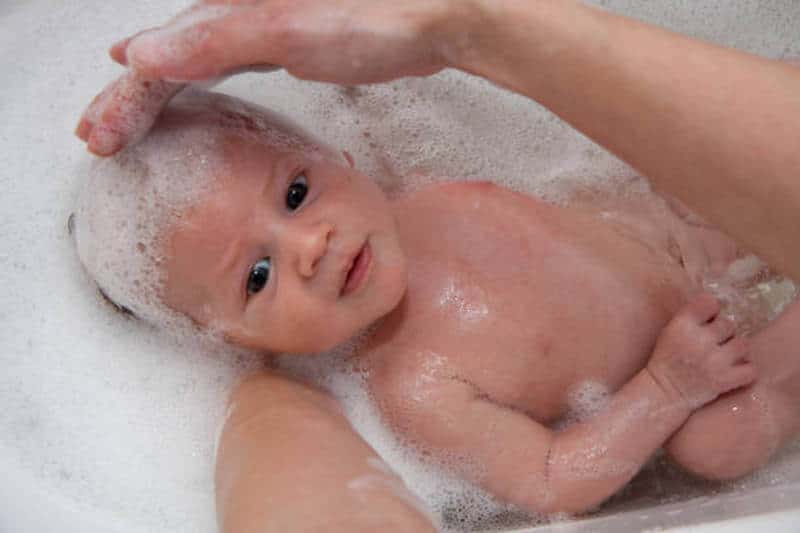
Apply Lotion and Diaper Cream
It’s important to keep your baby’s delicate skin moisturized and protected, so applying lotion and diaper cream after their bath is a must.
Moisturizing your baby’s skin has several benefits, such as preventing dryness and cracking, which can lead to discomfort for your little one. Plus, it helps maintain the natural barrier of their skin that protects against harmful bacteria and irritants.
When choosing a diaper cream, look for one that contains zinc oxide or petrolatum. These ingredients create a protective layer over your baby’s skin and reduce friction from diapers. Additionally, if your baby experiences diaper rash or irritation, consider using a cream with soothing ingredients like aloe vera or chamomile.
Remember to apply the cream in a thin layer to avoid clogging their pores and causing further irritation. By taking these extra steps in caring for your baby’s skin, you’re ensuring they stay comfortable and healthy.
Dress Your Baby
Now that you’ve successfully rinsed and dried your baby, it’s time to dress them up in some comfortable clothing.
Remember to always choose soft and breathable fabrics that won’t irritate your baby’s delicate skin.
Dress your little one appropriately for the weather, ensuring they’re warm enough in cooler temperatures and cool enough in warmer weather.
Finally, don’t forget to properly secure diapers and clothing to keep your baby safe and comfortable throughout the day.
Choose Comfortable Clothing
Dressing your little one in cozy, soft clothes is key to ensuring they stay warm and comfortable after they’ve had their first bath. Choosing appropriate clothing for your newborn can be overwhelming, but remember to consider their comfort and safety.
Avoid clothing with small buttons or ties that can be a choking hazard, and opt for clothes that are easy to put on and take off. Soft cotton onesies, footed pajamas, and leggings are great options for your baby.
Make sure the clothing you choose fits well without being too tight or too loose. You want your baby to have room to move comfortably while still feeling snug and secure. By choosing comfortable clothing for your little one, you’ll help them feel safe and content as they adjust to life outside the womb.
Dress Your Baby Appropriately for the Weather
Make sure your baby is dressed appropriately for the weather conditions to ensure they stay comfortable and warm during outdoor activities. Layering clothes is key, especially during colder months.
Start with a cotton onesie as a base layer, followed by a fleece or wool sweater and pants. Finish off with a jacket or snowsuit that is water-resistant and has a hood to protect their head from wind and snow.
Choosing appropriate fabrics is also important in keeping your baby warm and dry. Look for clothes made from breathable materials like cotton, which will allow sweat to evaporate instead of trapping moisture against their skin. Avoid synthetic materials like polyester, which can trap heat and cause overheating or irritation.
Additionally, make sure any outerwear is windproof and waterproof to protect them from the elements while outside.
By dressing your baby appropriately for the weather, you can ensure they’re comfortable and safe during outdoor activities all year round.
Secure Diapers and Clothing
It’s essential to properly secure your baby’s diapers and clothing to prevent discomfort, distractions, and potential safety hazards during outdoor activities. A snug fit is necessary for the diaper to stay in place and avoid leaks. Ensure that the diaper is tight enough around the waist but not too tight that it causes irritation or leaves marks on your baby’s skin.
Also, be mindful of how you dress your baby for outdoor activities, especially during hot weather. Dressing them in loose-fitting clothes made with breathable materials can help prevent overheating and rashes.
Avoiding irritation is also crucial when securing your baby’s clothing. When dressing them for outdoor activities, make sure there are no rough edges or seams that could cause discomfort or chafing against their delicate skin. Be careful when putting on socks as they can easily bunch up or slip off if not correctly secured.
Remember, happy babies mean happy parents! Taking the time to properly secure your little one’s diapers and clothing will ensure a comfortable and stress-free experience for both you and your baby while out enjoying nature together.
Tips and Tricks for a Fun and Safe Bath Time
When it comes to bath time, there are a few things you can do to make it fun and safe for your baby. Singing songs and playing with toys can help distract them from the unfamiliar experience of being in water.
Making eye contact and talking to your baby will also help them feel more comfortable and connected with you. But above all, never leave your baby unattended in the bath – even for a second!
By following these tips, you’ll be able to create a positive bath time experience for both you and your little one.
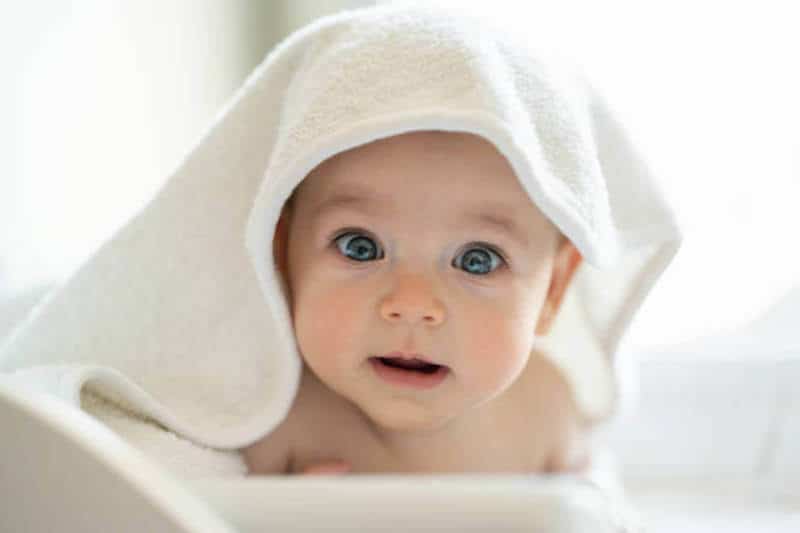
Sing Songs and Play with Toys
Let’s make bath time fun for your little one by singing songs and playing with toys! These bonding activities not only make the experience enjoyable for your baby but also strengthen the bond between you two.
Singing songs can be calming, entertaining, and a great way to teach your child new words. You can sing lullabies or nursery rhymes while washing their hair or scrubbing their body. You can even make up silly songs about the bubbles in the tub! Your baby will love hearing your voice and may even start cooing along.
Playing with toys is another way to make bath time fun. You can bring out rubber ducks, boats, or other water-friendly toys that your baby can play with while getting clean. This will keep them entertained and distracted from any discomfort they may feel during the bathing process.
It’s important to choose age-appropriate toys that don’t pose any choking hazards and are easy to clean after use. Incorporating these simple tips into your bath time routine will not only ensure a safe and effective cleaning process for your newborn but also create a positive experience that they’ll look forward to every day!
Make Eye Contact and Talk to Your Baby
Now that you’ve sung songs and played with toys during your baby’s bath time, it’s time to take the bonding experience to the next level.
Making eye contact and talking to your little one can help strengthen your connection and promote their development.
As you wash your baby, make sure to maintain eye contact as much as possible. This will not only help them feel more secure but also encourage their visual development.
Talking to them in a soothing voice can also have a calming effect on both you and your baby. You can narrate what you’re doing or simply tell them how much you love them.
These simple actions can go a long way in building trust and creating a positive association with bath time for your little one.
Bonding techniques like these are essential for developing healthy relationships between parents and children, so don’t underestimate their importance!
Never Leave Your Baby Unattended in the Bath
It’s crucial to never leave your baby alone in the tub, as accidents can happen in a split second and have serious consequences. While it may be tempting to step away for just a moment to grab a towel or answer the phone, it’s important to remember that infants can drown in even just an inch of water.
It only takes a few seconds for something to go wrong, so make sure you are always supervising your baby during bath time. One way to ensure constant supervision is by keeping all bath time supplies within arm’s reach before starting the bath. This includes soap, shampoo, washcloths and towels.
That way, if you need something during the bath, you won’t have to leave your baby unattended. Additionally, consider using a non-slip mat or cushioned bathtub insert to help keep your baby secure during the bath.
By taking these precautions and never leaving your baby alone in the tub, you can create a safe and enjoyable bathing experience for both you and your little one.
Conclusion
Bath time can be a wonderful bonding experience for both you and your baby. By following these steps, you’ve ensured that your little one is clean and safe.
Remember to always supervise your baby during bath time and never leave them unattended. As they grow, their needs will change, so it’s important to stay informed about the best practices for bathing infants and young children.
If you ever have any concerns or questions about bathing your newborn, don’t hesitate to reach out to your pediatrician. They’re there to help guide you through this exciting and sometimes overwhelming journey of parenthood.
Keep up the great work!
